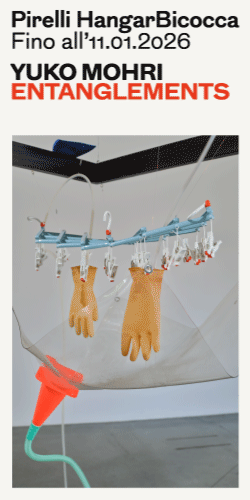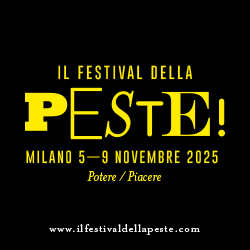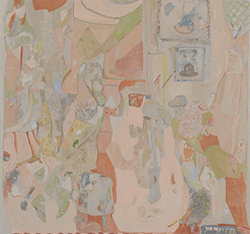
English text below —
Sarà un anno intenso quello di Emilio Vavarella, artista siciliano il cui lavoro coniuga ricerca interdisciplinare e sperimentazione mediale. In questi mesi sta lavorando alla realizzazione di due importanti progetti, “rs548049170_1_69869_TT(The Other Shapes of Me)” – vincitore della VI edizione di Italian Council (2019) – e Mnemoscopio (Mnemoscope) un progetto sostenuto dal MiBACT e da SIAE. Entrambi i progetti sono curati e prodotti da Ramdom, l’associazione di produzione culturale e artistica con sede a Gagliano del Capo, in provincia di Lecce.
In occasione di questi due importanti impegni, abbiamo posto alcune domande all’artista.
Elena Bordignon: Attualmente stai frequentando come ricercatore l’Harvard University, dove stai conseguendo un dottorato in Film, Visual Studies e Critical Media Practice. Mi racconti come questa esperienza influenza e arricchisce la tua pratica artistica? Ci sono dei nessi, sia teorici che pratici, tra le tue ricerche accademiche e le tue opere?
Emilio Vavarella: Tutte le mie opere nascono da una riflessione sull’impatto del potere tecnologico sulle nostre vite e sul nostro pensiero. La mia tesi di dottorato, interdisciplinare e ancora in fase di sviluppo, si focalizza proprio sulla relazione tra la tecnologia e il concetto di essere umano, in diversi momenti storici. E’ una tesi accademica semplicemente perché questo è il medium più adatto a questo tipo di lavoro, ma la tesi è anche un’estensione di un corpus di lavori interdisciplinari che investiga il rapporto essere umano-tecnologia utilizzando di volta in volta un medium diverso e da un punto di vista diverso. Ad Harvard ho l’opportunità di portare avanti la mia ricerca artistica utilizzando le tecniche, i materiali, e i metodi che meglio danno forma alle mie domande, spaziando dalla teoria alla pratica a seconda di ciò che ogni specifico progetto richiede.
EB: In occasione di una tua personale alla Gallleriapiù di Bologna (Dicembre – Gennaio 2019), RE-CAPTURE: Room(s) for Imperfection, in un’intervista, hai affermato: “Preferisco lavorare per esperimenti ed ipotesi, sempre pronto a rimettere in discussione punti di partenza e di arrivo.” Questa tua necessità di confrontarti sia con la genesi che con i risultati del processo artistico, mi induce a vederti come un artista – scienziato che necessita di dover compiere sempre dei test sul proprio operato. Mi racconti da cosa parti per concepire un’opera? Come ne sviluppi l’idea e la concretizzi?
EV: In linea di massima tutte le mie opere nascono da un lungo percorso di ricerca concettuale e tecnologica su molteplici livelli, seguito da una formalizzazione in cui gli spunti e le riflessioni che costellano la mia ricerca trovano una loro sintesi visiva e concettuale. La spinta iniziale è sempre la curiosità di andare conoscere ciò che ancora non so e di riuscire a vedere ciò che non è ancora visibile. Nel corso degli anni ho dato vita ad un archivio molto esteso di work-in-progress: collezioni di documenti, immagini, testi, appunti o altri materiali su cui torno ciclicamente. Potrei dire che queste collezioni sono il modo attraverso cui nutro, a volte anche per anni, idee ancora ad uno stato embrionale o in lenta evoluzione. Ma non si tratta mai di un’evoluzione lineare. Con il progredire delle mie ricerche comincio a implementare le prime ipotesi, teorie, tecniche, ed a sperimentare diversi metodi di lavoro, alla ricerca di quelli più affini ai materiali ricercati e alle domande in questione. L’opera finale arriva sempre in seguito ad un’improvvisa correlazione tra ricerche e materiali precedentemente distinti. Potremmo dire che l’opera finale nasce solo a questo punto, allo stabilirsi di una connessione che scavalca ogni apparente inconciliabilità per proporre una nuova ipotesi di realtà.
EB: Il tuo lavoro si è connotato, nel tempo, come ‘interdisciplinare’. Quali discipline extra-artistiche senti più consone con la tua ricerca? Quanto il ‘potere tecnologico’ ti condiziona?
EV: Penso che il potere della tecnologia rappresenti la maggiore fonte di influenza sulla vita di un essere umano, e credo che nessun essere umano sia mai stato immune da questo tipo di condizionamento. Ogni tecnologia è il prodotto delle nostre attività tanto quanto noi esseri umani siamo, da ogni punto di vista, il prodotto di particolari tecnologie. Umanità e tecnologia sono l’una il prodotto dell’altra, e il concetto stesso di ‘natura umana’ è inscindibile da quello di ‘tecnologia.’ Tutto ciò che sappiamo di noi stessi e della nostra storia è che non sono mai esistite né culture, né forme di vita umana, di tipo pre-tecnologico. Il rapporto tra questi due termini – umanità e tecnologia – è improntato alla loro mutua riproduzione, e un’ipotetica risoluzione del loro rapporto comporterebbe un radicale stravolgimento del concetto stesso di umanità. Però, nonostante non vi possa essere alcuna umanità al di fuori di un continuo condizionamento tecnologico, nel corso di migliaia di anni ogni cultura ha inventato nuovi modi per mediare il proprio rapporto con la tecnica e la tecnologia. Proprio per questo mi interessano tutte quelle discipline che, in un modo o in un altro, dall’ingegneria alla filosofia, si occupano di mediare il nostro rapporto con la tecnologia.

EB: Hai in programma due importanti progetti per il 2020: “rs548049170_1_69869_TT (The Other Shapes of Me)”, vincitore della VI edizione di Italian Council (2019), e Mnemoscopio (Mnemoscope,) un progetto sostenuto dal MiBACT e da SIAE (entrambi curati e prodotti da Ramdom). In merito al primo progetto citato, mi racconti la sua genesi? Quali spunti iniziali hai sviluppato?
EV: L’opera è il risultato di un lungo processo performativo durante il quale un grande tessuto che codifica e contiene tutte le mie caratteristiche genetiche viene prodotto da mia madre utilizzando un telaio Jacquard di fine ‘800. L’opera finale si compone di tre parti: il tessuto, il telaio, e un video della produzione. L’opera nasce da una ricerca sull’origine delle tecnologie di tipo binario e sulle sue applicazioni più avanzate. Questa ricerca mi ha immediatamente portato ad interessarmi alla storia del tessile, poiché il primo telaio automatizzato di epoca moderna, il telaio Jacquard, può essere considerato come il primo vero computer. In altre parole, informatica e tessitura condividono, a inizio ‘900, le stesse tecniche di programmazione.
Ma i parallelismi che ho cominciato a investigare riguardano anche il tema del lavoro femminile, che include tanto il mondo domestico della tessitura quanto quello delle prime programmatrici e operatrici di macchine computazionali. Infine, tornando alle più recenti applicazioni dell’informatica, ci sono sicuramente quelle legate agli studi sulla genetica, che mi interessano molto. Il codice genetico non è altro che la codifica, effettuata da tecnologie binarie, delle informazioni contenute all’interno delle nostre cellule. Da qui l’idea di processare il mio codice genetico, con il fondamentale apporto di mia mamma, utilizzando il primo computer moderno: il telaio Jacquard di fine ‘800. L’opera è il risultato di questo processo sperimentale e non-lineare che ripercorre simbolicamente tutta la storia della tecnologia binaria: dalla tessitura alla programmazione, agli algoritmi, software, ai processi di automazione, fino alla completa informatizzazione di un essere umano.
EB: Mnemoscopio è un progetto che pone al centro il concetto di “memoria collettiva”. Anche in questo caso, mi racconti quali idee iniziali hai considerato – o scartato – prima di rendere realizzabile questo complesso progetto?
EV: Durante la progettazione di questo lavoro mi sono soffermato a riflettere su come esso potesse espandere una serie di altri lavori incentrati sul rapporto tra memoria e tecnologia. In THE SICILIAN FAMILY (2012-‘13) ho lavorato sulla distorsione tecnologica di memorie di famiglia; e in MNEMODRONE (2014) ho esplorato la possibilità di costituire un’intelligenza artificiale sulla base di memorie condivise con un drone, in MNEMOGRAFO (2016) ho lavorato sul riaffiorare di memorie in Rete, e su alcune mie memorie d’infanzia; ed in MEMORYSCAPES (2013-‘16) ho lavorato sul potenziale cartografico di italiani emigrati, come me all’epoca, a New York.
MNEMOSCOPIO (2020) andrà ad ampliare questo corpus di opere focalizzandosi sulla questione della memoria collettiva di coloro che sono partiti da Gagliano del Capo – luogo in cui Ramdom opera attivamente – per poi farvi ritorno. Dal punto di vista tecnico l’opera coniugherà una forte dimensione estetica ed esperienziale con alcune soluzione tecnologiche sperimentali ed un approccio installativo e fruitivo site-specific. Penso a questo lavoro come ad una installazione pubblica effimera e diffusa sul territorio del Capo di Leuca, un viaggio nel viaggio, insomma.


Interview with Emilio Vavarella
Emilio Vavarella is an artist whose work blends interdisciplinary art practice and theoretical research and is centered around the study of the relationship between humans and technological power. His works present a combination of using new technologies with alternative (non-productive, poetic, dysfunctional) goals in mind, imagining technology’s future effects through the use of speculative fiction, and decontextualizing and misusing technology to reveal its hidden mechanisms.
Elena Bordignon: You are currently attending Harvard University as a researcher, doing a PhD in Film, Visual Studies and Critical Media Practice. Can you tell me how this experience influences and enriches your artistic practice? Are there any links, both theoretical and practical, between your academic research and your work?
Emilio Vavarella: All of my projects start from a reflection on the impact of technological power on our lives and our thinking. My interdisciplinary PhD thesis, currently in progress, focuses on the relationship between technology and the concept of “human being”, in different historical moments. It is an academic thesis simply because this is the most suitable medium for this kind of work, but the thesis is also an extension of a body of interdisciplinary works that investigates the relationship between human beings and technology, using a wide range of mediums and different points of view. At Harvard I have the opportunity to pursue my artistic research using the techniques, materials, and methods that can give form to my questions, ranging from theory to practice depending on what each specific project requires.
EB: On the occasion of your solo show at GALLLERIAPIÙ in Bologna (December – January 2019), RE-CAPTURE: Room(s) for Imperfection, in an interview, you said: “I prefer to work with experiments and hypotheses, and I am always ready to question both starting and ending points”. This need to confront yourself both with the genesis and with the results of the artistic process, leads me to see you as an artist-scientist who always needs to test his own work. Can you tell me what is your starting point for a new work? How do you develop the idea and then concretize it?
EV: Generally speaking, all my works are the result of a long process of conceptual and technological research on multiple levels, followed by a formalization in which the ideas and reflections that punctuate my research find their visual and conceptual synthesis. The initial drive is always a curiosity to know what I still don’t know, and to to see what is still not visible. Over the years I have created an extensive archive of works-in-progress: collections of documents, images, texts, notes and other materials to which I cyclically come back. I could say that these collections are my way of nourishing, sometimes for years, ideas that are still in an embryonic or slowly evolving state. But these ideas never follow a linear evolution. As my research goes on, I begin to implement hypotheses, theories, techniques, and I experiment with different working methods, in search of those more attuned to the materials researched. The final work takes form only after some correlation emerges between previously distinct materials. We could say that the final work is born precisely at that point: when a connection that goes beyond any apparent irreconcilability is established and a new reality seems suddenly possible.
EB: Your work has been described, over the past few years, as ‘interdisciplinary’. Which extra-artistic disciplines do you feel are best suited to your research? How much does ‘technological power’ condition you?
EV: I think that the power of technology represents the greatest source of influence on the life of every human being, and I believe that no human has ever been immune to this kind of conditioning. Every technology is the product of our activities as much as we humans are, from every point of view, the product of particular technologies. Humanity and technology are the product of each other, and the very concept of ‘human nature’ is inseparable from that of ‘technology.’ All we know about ourselves and our history is that there have never been pre-technological cultures or pre-technical forms of human life. The relationship between these two terms – humanity and technology – is marked by their mutual reproduction, and a hypothetical resolution of this relationship would involve a radical upheaval of the very concept of humanity. However, although there can be no humanity outside of a continuous technological conditioning, it must be noted that over thousands of years of human civilization every single culture has invented new ways to mediate its relationship with technology. This is precisely why I am interested in all those disciplines that, in one way or another, from engineering to philosophy, mediate our relationship with technology. It is all we can do.

EB: You are planning two important projects for 2020: “rs548049170_1_69869_TT (The Other Shapes of Me)”, winner of the VI edition of the Italian Council (2019), and MNEMOSCOPIO (MNEMOSCOPE,) a project supported by MiBACT and SIAE (both edited and produced by Ramdom). Regarding the first project mentioned, can you tell me about its genesis? What initial ideas did you develop?
EV: The work is the result of a long performative process during which a large textile, encoding and containing all my genetic characteristics, is produced by my mother using a 19th century Jacquard loom. The final work will consist of three parts: the fabric, the loom, and a video of the production. The work is the result of a research into the origin of binary technology and into its most advanced applications. This research immediately led me to take an interest in the history of textiles, since the first automated loom of modernity, the Jacquard loom, can be considered as the first real computer. In other words, at the beginning of the 20th century, computer science and weaving shared the same programming techniques. But the parallels emerging from this research also concern the theme of women’s work, which includes both the domestic world of weaving and that of the first programmers and operators of computational machines. Finally, going back to the most recent applications of computer science, there are certainly those related to studies on genetics, which interest me a lot. The genetic code is nothing more than the encoding, carried out by binary technologies, of the information contained within our cells. Hence the idea of processing my genetic code, with the fundamental contribution of my mother, using the first modern computer, the late 19th century Jacquard loom. The work is the result of this experimental and non-linear process that symbolically retraces the whole history of binary technology: from weaving to programming, algorithms, software, automation processes, up to the complete computerization of a human being.
EB: MNEMOSCOPE is a project that focuses on the concept of ‘collective memory.’ What initial ideas did you consider – or discard – before making this complex project feasible?
EV: During the first stages of working on MNEMOSCOPE I was thinking about the ways in which it could potentially expand on a series of previous works focused on the relationship between memory and technology. In THE SICILIAN FAMILY (2012-’13) I had worked on the technological distortion of family memories; and in MNEMODRONE (2014) I had explored the possibility of building an artificial intelligence based on memories shared with a drone; in MNEMOGRAFO (2016) I had worked on the resurfacing of memories on the Internet and on some of my childhood memories; and, finally, in MEMORYSCAPES (2013-’16) I had worked on the cartographic potential of Italians who emigrated, like me at that time, to New York. MNEMOSCOPE (2020) will push this line of research even further. It will expand on this layered body of works by focusing on the collective memories of those who left Gagliano del Capo – the place where Ramdom actively operates – and then returned to it. From a technical point of view this work will combine a strong aesthetic and experiential dimension with some experimental technological solutions and with a site-specific sensibility. I think of this work as an ephemeral and widespread public installation on the territory of Capo di Leuca, a journey in the journey, in short.










